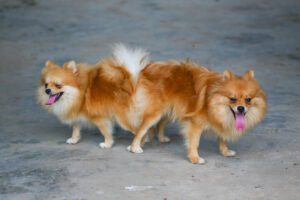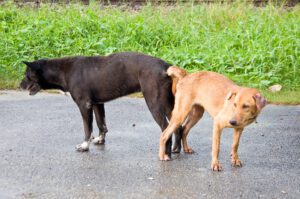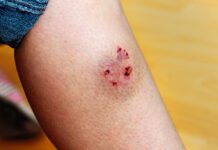
If you have just observed two dogs mating for the first time, you may be shocked and concerned; it can look a little disturbing. The way dogs mate is unique among the mammalian species – particularly the part where the dogs get “stuck” together by their genitalia, in a butt-to- butt stance. Sometimes the dogs themselves become alarmed by their inability to escape from their partner, and may yelp or scream in apparent pain or discomfort. That’s when concerned owners or bystanders to an unplanned canine mating may try various things to separate the dogs, from physically pulling them apart to spraying them with water from a cold hose. Both of these tactics are not only ineffective but also cruel and possibly injurious to the dogs. The best thing to do is keep the dogs calm and contained (just snap a leash onto each dog’s collar) and wait for the process to end; they will separate naturally within about five to 45 minutes.
Why Dogs Get “Stuck” When Mating

An intact female dog has two phases to her heat cycle (see “How long are dogs in heat?”). It is during the second phase that she will enter estrus, the period of time during which she will become receptive to being mated with an intact male dog.
The female dog begins the mating process by positioning her tail to the side and allowing the male dog to mount her. The male dog becomes aroused and his penis will become erect and protrude from the prepuce. The male dog will stand on his hindlimbs and grasp the female dog around her “waist” with his forelimbs.
Once mounted, the male dog’s penis enters the female dog’s vagina. The male dog thrusts his hips back and forth for about one to two minutes. Semen is deposited into the female’s vagina during this process. This is the first stage of coitus (intercourse).
Then the male dog will dismount from the female dog and stand with both forelimbs to one side of the female dog. He then swings one hindlimb over the female dog’s hind end. This is called the turn; it marks the end of the first stage and the beginning of the second stage of coitus.
Once the male dog has turned, both dogs will stand facing opposite directions with their hind ends touching. The vulva of the female dog is lined with smooth muscle that contracts around the male dog’s bulbus glandis – a round swelling that surrounds the base of the penis. The contraction of the vulva and muscle contractions at the base of the penis prevent blood from leaving the penis and keeps the penis erect. People who breed dogs call the locking of the vulva around the penis is called “the tie” – most dog owners call it “getting stuck.”
During the second stage of coitus, the male dog will steadily deposit semen into the vagina. Since the vulva and the penis are locked together, the pressure inside the vagina increases. This forces the semen (and therefore the sperm) into the uterus so that the sperm can fertilize the eggs to create little puppy embryos.
The second stage of coitus can last anywhere from five to 45 minutes. Once the smooth muscle of the vulva relaxes, blood is allowed to leave the penis. The erection ceases and the male dog removes his penis from the female dog’s vulva and walks away.
Once dogs have become tied, it is important to let the process resolve naturally. Attempting to “unstick” dogs who are tied can result in serious harm to one or both dogs. The smooth muscle of the vulva is strong and the penis is swollen and erect, essentially locking the penis within the vagina. This is similar to inserting a key in a lock and turning the key; the key will not come out of the lock until the key has been returned to its original position. Once the vulva has relaxed and the penis is no longer erect, the dogs will “unstick” themselves.
A successful tie or even the length of the tie does not guarantee pregnancy – and interrupting the process does not guarantee the prevention of a pregnancy. Other factors play a role in whether or not a dog becomes pregnant, including fertility of the female, sperm count of the male, and the overall health and the age of each dog.
How to Know if Your Dog Is Pregnant
There are two tests to determine whether or not a dog is pregnant. One of these is a test for the hormone relaxin. This is a blood test that can be done by your dog’s veterinarian. Relaxin is produced by the placenta that surrounds the puppy embryos. This hormone is produced starting between day 22 and 27 of pregnancy.
The second test for pregnancy is an ultrasound completed by your dog’s veterinarian. Puppy embryos can be seen on ultrasound as early as three weeks into your dog’s pregnancy.
There is no urine test for pregnancy in dogs like there is for people. There are pregnancy tests that you can purchase on-line for your dog. However, these are blood tests that require that you be comfortable with drawing blood from your dog. For most people, having the blood test completed by their dog’s veterinarian is the safer and easier choice.
Abortion Options for Unwanted Pregnancies
If your dog becomes pregnant and the pregnancy is not desired, there are two options for terminating the pregnancy. Each option carries with it some level of risk for your dog.
The first option is having your dog spayed as soon as possible. There is always risk associated with any surgical and anesthetic procedure. But when a dog is pregnant, there is increased blood flow to the uterus to provide nutrition to the puppy embryos. This increases the risk of bleeding during the spay procedure.
The second option is an injectable medication called dinoprost (also known as prostaglandin F2-alpha) This medication is given twice a day until the puppy embryos are aborted. The earliest this medication can be given is at day 25 of pregnancy. The average length of pregnancy in dogs is 63 days.
Side effects of dinoprost in dogs include abdominal pain, vomiting, increased heart rate, restlessness, anxiety, fever, drooling, difficulty breathing, and panting. Death of the pregnant dog is a possible complication. Dinoprost can be combined with intravaginal administration of a drug called misoprostol to decrease the dose of dinoprost required to terminate a pregnancy.
Preventing Unwanted Pregnancy
If your reproductively intact female dog is in heat and you do not want her to become pregnant, keep her indoors and away from intact male dogs. Closely supervise her when she is outside to ensure that an intact male dog does not come near her. The influence of hormones on the desire to procreate is strong with intact male dogs and with female dogs that are in the second phase of their heat cycle.
The easiest way to prevent a pregnancy in an intact female dog is to have her spayed. Talk to your veterinarian about the appropriate age at which to have your dog spayed.





